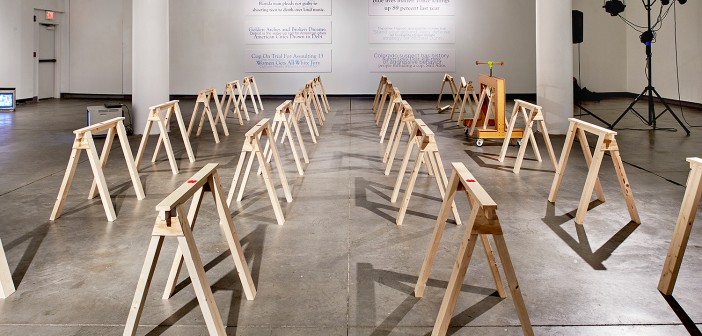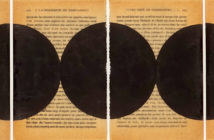In today’s politically charged atmosphere, social unrest has become so ubiquitous that it has even become the subject of an exhibition in Portland, Maine–a city known more for its cobblestone streets and fine restaurants than for its raucous political scene. Despite, or perhaps because of, the soporific nature of day-to-day life and media exposure, it is the frantic and inflamed political circus that often seems to command the lion's share of public attention. Echoing this condition, Tinderbox, on view at the Maine College of Art’s Institute of Contemporary Art through March 5th, explores extant social and political strife through the works of several artists.
Tinderbox reads both as a warning and an admonishment. The term, as curator Kyle Patanaude notes in his statement, “colloquially refers to a container for tinder, material poised for ignition. What it resonates towards here, [sic]is the raging society we are currently living in, already ablaze.”[i] While it is indisputably true that the world is “already ablaze,” much of the artwork that forms the core of Tinderbox seems content to represent the general condition or abstracted feeling of continued injustice, rather than identify its causes.
The curatorial thrust of the show is overly emphatic when compared to the artworks, which gesture towards social justice and, more than anything, towards the absence of healthy communities and social relationships. Although none of the artists involved use political imagery (images of politicians, marches, protests, or government institutions, for instance), Tinderbox as a whole seems explicitly political. The curatorial choices tie the artists’ gestures to specific events in recent political history. This approach makes the work seem more vocal than it really is, and crowds the messaging of the show.
That’s a shame, because much of the work is very strong–certainly strong enough to speak for itself. The first gallery, for instance, contains Indicators: a series of blank sandwich boards by the Martine Kaczynski. Upon closer inspection, the boards are more intricate than they first appear, having been painted on their sides and bellies in eye-catching colors. Yet their primary attribute is their blankness, a semiotic void that immediately brings to mind the state of dislocation typical of postmodern society.[ii] It is only upon being struck by the absence of instruction that we realize that we have been directed to expect such instruction in the first place.

Trina May Smith, Fire 8, 2015, acrylic and oil on panel. Institute for Contemporary Art at the Maine College of Art. Photo by Michael Wilson.
Surrounding the Indicators are works in oil by Trina May Smith, paintings depicting abandonment or dilapidation. Large oil paintings of plywood sheets covering doorways give way in the adjoining hallway to smaller works in acrylic and oil, this time with abandoned houses or shops as the primary subject matter. In later pieces, the houses are ablaze. These paintings are obviously the products of many hours of work and are convincing in the depiction of their subjects. The artist evokes questions about the nature of beauty by painting destructive or dispirited real estate with care and attention. Forced 2 features a series of small, run-down houses lined up in front of a sidewalk. The transitions between buildings and the conflicting directions of the shadows make it clear that the image is a composite that has been painted as a single scene. The sense of dislocation is palpable; it becomes evident that in Smith’s world we cannot trust even the sun to shine in one direction. These paintings aren’t conceptually complex, nor do they need to be. They assert a forceful message of dislocation, abandonment, and collapse.
Similar preoccupations, although more sentimental, find their expression in the prints of Tyanna Buie. Her pair of monoprints of broken swings merge a careful technique careful technique with a looseness that makes the works seem fresh and alive. However, her largest piece, the mammoth Sweet Escape, is composed of so many kitsch artifacts (a flower, wings, a handwritten letter in the background) that it ends up resembling the cover of a teenager’s Trapper Keeper, or a stock memorial tattoo. And Buie is doubtlessly neither the first artist nor the last to use faceless portraits as an expression of loss.

Tyanna Buie, Sweet Escape, 2012, acrylics, screen-print on paper. Institute for Contemporary Art at the Maine College of Art. Photo by Michael Wilson.
The last gallery houses an installation, We Love to Wait in Lines, by Adam Manley, which represents a simple metaphor of systematic oppression. A group of thirty sawhorses have been assembled, equally spaced throughout the gallery. At regular intervals, a custom made machine is brought to each sawhorse and a piston is hand torqued to crush the “back” of the horse. The message could not be clearer: we are victims of the machine, only waiting to be consumed and broken by it. But the most frightening aspect of the artwork might be that the resulting mess is beautiful in its own right. Each sawhorse breaks differently; some merely crack, some shatter, and others lose the ability to stand at all, falling into halves and sending splinters scattering in their immediate vicinity, the evidence of their demise.
The last gallery is also the site of the “Public Aggregation Area,” an uncredited installation that features a series of headlines from newspapers, primarily in reference to the events surrounding the numerous conflicts between police and Black Lives Matter protesters in the wake of the continued deaths of civilians at the hands of police officers. Tinderbox doesn’t take an explicitly political stand one way or the other, instead choosing to highlight headlines sympathetic to both sides of the conflict. While viewers on either side of the political spectrum might object to this choice, the apparent lack of bias has no real impact on the aesthetics of the show. While the inclusion of video installations and printed headlines diversify the variety of media offered by Tinderbox and make it seem more “full,” there is no compelling justification for bringing them into art galleries, particularly if the resulting presentation lacks both interpretative value and aesthetic merit. Neither video nor text is presented in an original or compelling manner here, beyond an attempt to muddle some of the newspaper headlines by interspersing them with each other, which only makes them more difficult to read.

Institute for Contemporary Art at the Maine College of Art. Photo by Michael Wilson.
For whatever is missing in Tinderbox, however, it does deal with difficult and uncomfortable territory in a manner that is ultimately compelling. For art to not engage contemporary social and political issues, to not address issues of alienation and oppression within society, represents a far greater failure than to engage these issues imperfectly. In the end, we leave our encounters with such work better prepared to deal with this “raging society,” both always and already ablaze.
Tinder Box is on view through March 5 at the Maine College of Art Institute of Contemporary Art.
[i] Kyle Patanaude, “Tinderbox Curatorial Statement.” Institute of Contemporary Art at the Maine College of Art, Winter, 2016.
[ii] Frederic Jameson, Postmodernism, or, the Cultural Logic of Late Capitalism (Durham, NC: Duke University Press, 1991), 42.




